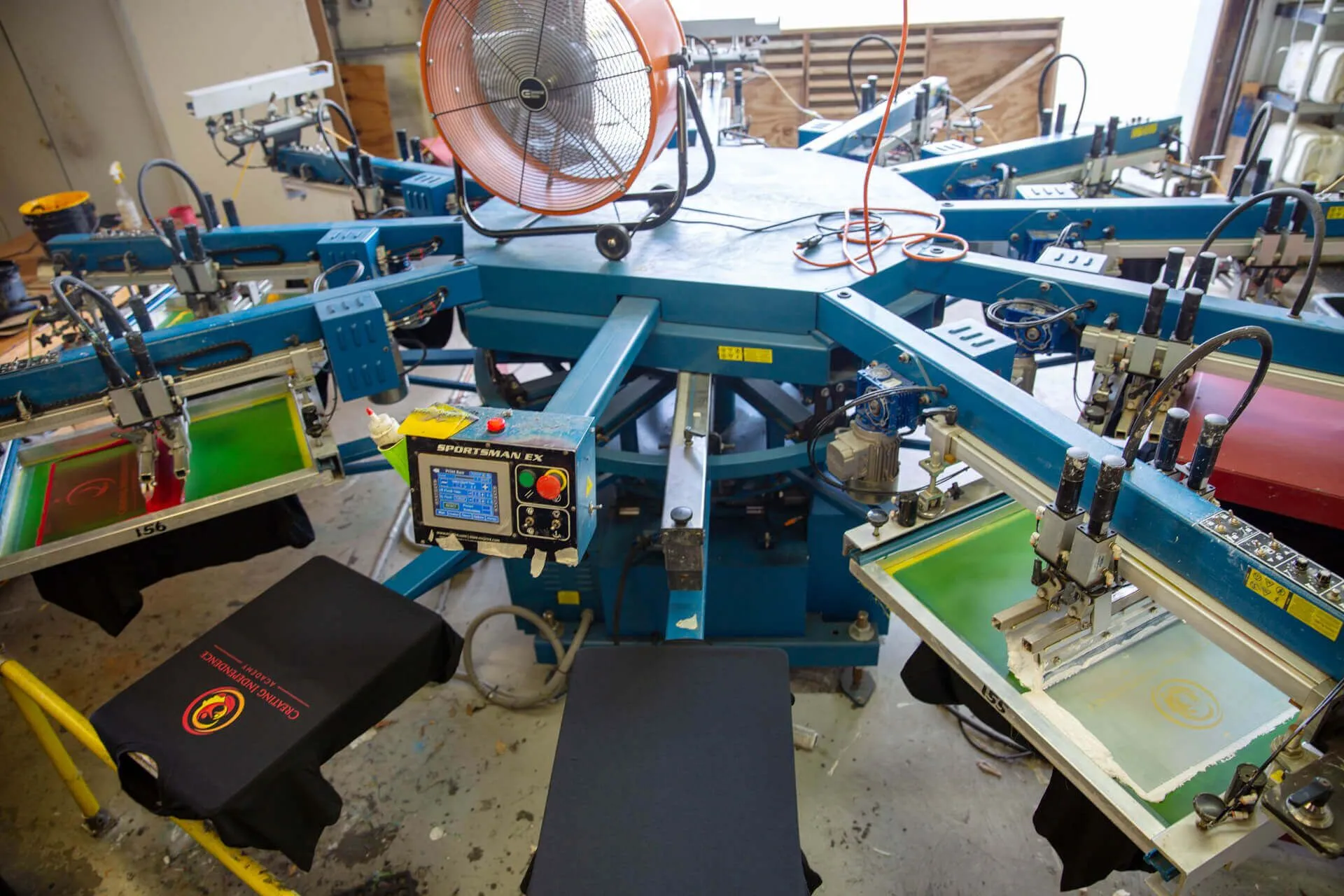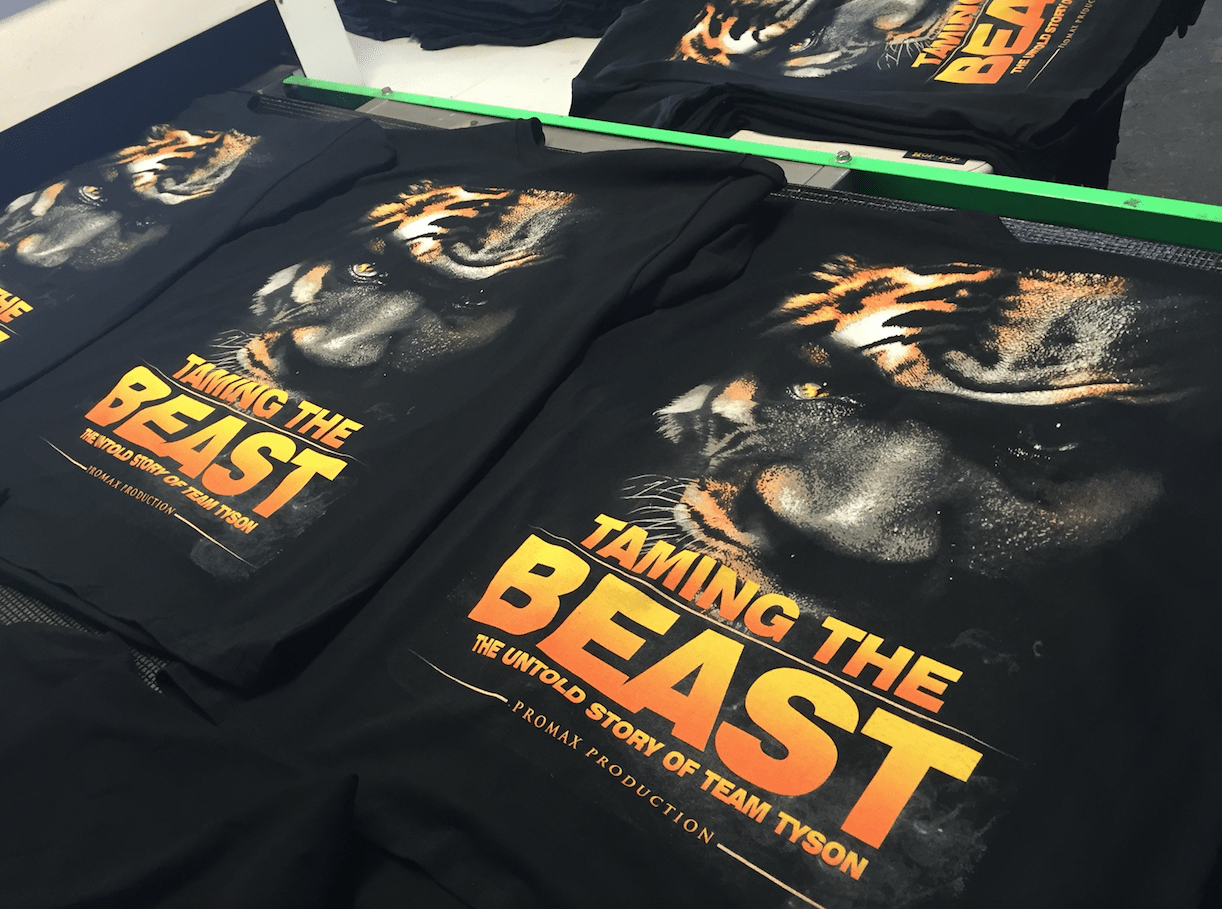Durable T-Shirt Printing for Everyday Wear
Wiki Article
Display Printing Uncovered: Every Little Thing You Need to Understand About Tee and Garment Printing Techniques
Display printing is an interesting method that integrates art with technique, offering endless possibilities for creativity. Ready to discover the necessary components that make display printing an art kind?
The Fundamentals of Display Printing: How It Functions
When you plunge right into screen printing, you'll uncover it's both an art and a scientific research. At its core, display printing entails producing a pattern, or screen, that permits ink to pass with only in certain areas.Following, you'll mix your inks and prepare your printing surface area. Position the display over the fabric, after that make use of a squeegee to push ink with the screen onto the garment. This procedure requires accuracy, as you desire clear, dynamic prints. After printing, you'll treat the ink with heat, ensuring it sticks to the fabric and lasts via laundries. Each action is crucial, and grasping them will certainly boost your screen printing abilities, transforming simple garments right into one-of-a-kind, meaningful pieces.
Kinds Of Screen Printing Techniques
Once you grasp the fundamentals of display printing, it's time to discover the different strategies that can elevate your designs. One prominent method is traditional display printing, where ink is pressed via a stenciled screen. This strategy is great for vibrant, vivid colors. Then there's water-based ink printing, which provides a softer feel and is environmentally friendly, yet it calls for a various strategy to curing.One more alternative is plastisol printing, known for its sturdiness and dazzling colors, making it a preferred for lots of brand names. Experiment with halftone printing to produce gradient results and detailed designs.
Essential Devices for Display Printing
To accomplish stunning lead to display printing, having the ideal tools is fundamental. You'll need a strong screen printing structure, which holds the mesh that moves your design onto the garment. Next off, purchase top notch mops; these are essential for applying ink evenly across the display. You'll additionally call for a great exposure unit to develop your screens, along with a washout cubicle for cleaning them after usage. A reliable heat resource, like a conveyor clothes dryer or heat press, is important for curing your prints to guarantee long life. Do not forget a proper work space, geared up with tables and storage space for your materials. Safety equipment, such as masks and gloves, will certainly maintain you secure from chemicals and inks. With the right devices, you'll be well on your way to creating professional-quality prints.Selecting the Right Inks and Products
When selecting inks and materials for screen printing, you need to consider the kind of ink that works finest for your job. Think about fabric compatibility to assure your styles look fantastic and last long. Check out environmentally friendly ink options to make your printing procedure more sustainable.Sorts Of Screen Inks
Picking the ideal display ink is crucial for attaining vivid, resilient prints that fulfill your project's demands. There are a number of types of screen inks to examine. Plastisol ink is preferred for its adaptability and ease of usage, supplying outstanding shade opacity on dark materials. Water-based ink, on the other hand, offers a softer feeling and is environmentally friendly, making it perfect for those looking to minimize their ecological impact. Release inks remove dye from the textile, leading to a soft, classic look however need specific handling. Ultimately, specialty inks, such as glow-in-the-dark or metal, can add one-of-a-kind impacts to your layouts. Review your job needs and choose the ink that lines up ideal with your preferred end result.
Fabric Compatibility Considerations
Comprehending fabric compatibility is essential for accomplishing top quality display prints, particularly since different materials respond distinctively to various inks. Constantly test your inks on example material to guarantee they adhere properly and preserve color integrity. Furthermore, maintain in mind that fabric weight and appearance can affect the final end result, so selecting the ideal ink and material combination is important for your task's success.Eco-Friendly Ink Options
Green inks are coming to be a prominent choice for screen printers that intend to lessen their environmental effect while keeping quality. When choosing inks, take into consideration water-based inks, which are less harmful and simpler to tidy up contrasted to typical solvents. These inks bond well with fabrics, delivering lively outcomes without toxic chemicals. You could additionally discover eco-solvent inks that use less volatile natural substances (VOCs), making them a much safer option for both your health and wellness and the world.Additionally, search for inks made from eco-friendly resources, such as soy or vegetable-based options. By selecting the ideal inks and materials, you'll not only produce stunning styles but likewise add to a much more sustainable printing process. Make the button, and your prints will certainly show Click This Link your commitment to the atmosphere!
Preparing Your Style for Screen Printing

File Layout Requirements
To assure your layout looks dynamic and sharp on textile, you'll need to pay close interest to file layout requirements for screen printing. Beginning with vector files like AI or EPS, as they can be scaled without shedding quality. If you utilize raster images, select high-resolution documents, such as TIFF or PNG, ideally at 300 DPI. Avoid utilizing JPEGs, as they can shed quality when resized. Make sure your layout has a clear background to avoid undesirable white sides on your prints. Ultimately, keep color modes in mind; CMYK is basic for screen printing, so convert your RGB designs appropriately. By complying with these standards, you'll set your artwork up for a successful print.Shade Separation Strategies
Color splitting up is a crucial step in preparing your style for display printing, and grasping it can significantly enhance your print quality. You'll require to break your style into specific colors, as each shade needs a different screen throughout printing. This accuracy not just guarantees accurate shade depiction however also simplifies the printing procedure.Resolution and Dimension
Accomplishing the most effective outcomes in screen printing starts with assuring your design has the appropriate resolution and size. Preferably, your art work ought to be at least 300 DPI (dots per inch) for sharp, clear prints. If you use lower resolution, your last product may look amateur and pixelated.When it comes to size, consider the measurements of your print area. Style your art work to match the last print dimension, ideally creating it in the real measurements you'll be publishing. By doing this, you'll prevent any unforeseen scaling concerns.
Constantly examine your style in both vector and raster layouts. Vector graphics can be scaled without shedding quality, making them suitable for display printing. Preparing correctly will assure your layout looks outstanding on every garment!
Step-by-Step Display Printing Refine
Display printing is a vibrant process that permits you to create vibrant layouts on numerous surface areas. To obtain started, you'll require a display, solution, and your selected ink.Pour ink onto the display and utilize a squeegee to press explanation the ink with the pattern onto the material. Raise the display meticulously and allow the print dry. You have actually effectively screen printed your design.
Tips for Effective Screen Printing Projects
While you're diving right into your screen printing tasks, keep in mind that preparation is key to success. Begin by gathering all your products-- inks, garments, displays, and squeegees. A clean work area aids stop unwanted errors, so neat up before you start.Next, confirm your artwork is high-resolution and effectively sized for your garment. Evaluate your screen for proper direct exposure and tidy it extensively to avoid spots. When blending your inks, follow the supplier's standards to achieve the ideal consistency.
During printing, use even stress with your squeegee for constant outcomes. Do not rush; take your time to validate each print meets your criteria. After printing, allow your garments dry totally prior to managing or packaging them.
Last but not least, always keep an example of your benefit future recommendation. This way, you can evaluate your progress and boost your methods in time. Pleased printing!

Regularly Asked Inquiries
For how long Does It Take to Establish a Display Printing Work?
Establishing up a screen printing work usually takes about 30 minutes to an hour. You'll prepare the screens, mix inks, and readjust journalism. The moment differs based upon complexity and experience, so stay arranged!Can I Publish on Different Fabric Keys In Making Use Of the Exact Same Method?
Yes, you can publish on various material types using the very same method, however you'll need to adjust your setups and inks. Some fabrics absorb ink differently, so experimenting warranties the most effective results for each and every product.What Prevail Mistakes to Stay Clear Of in Display Printing?
When screen printing, prevent typical errors like using the incorrect ink, overlooking proper direct exposure times, or missing pre-press checks. Constantly test your arrangement and maintain tidy displays to guarantee top quality results each time.Just How Can I Appropriately Clean and Keep My Screen Printing Tools?
To appropriately tidy and preserve your display printing equipment, you should consistently clean screens with appropriate solvents, check squeegees for wear, and ensure all devices are saved completely dry and dust-free. Consistency protects against costly repair services and improves efficiency.Is Display Printing Eco-friendly Contrasted to Other Techniques?
Display printing can be much more eco friendly than other approaches, especially if you make use of water-based inks and eco-conscious materials. By picking sustainable supplies and methods, you minimize waste and reduce your influence on the world.Screen Printing Uncovered: Whatever You Required to Know Concerning T-Shirt and Garment Printing Techniques
At its core, screen printing entails producing a pattern, or display, that permits ink to pass via just in certain locations. Placement the screen over the fabric, then use a squeegee to press ink via the screen onto the garment. One popular method is standard display printing, where web link ink is pushed through a stenciled screen.When choosing inks and materials for screen printing, you require to take right into account the kind of ink that works best for your project.
Report this wiki page